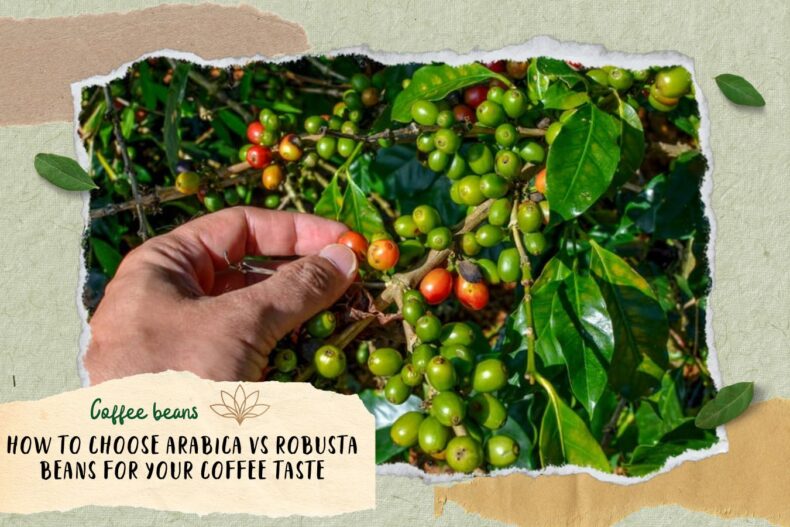
Origin Of Arabica Coffee: The Oromo people of Ethiopia used coffee centuries before the Kaldi legend and have their tales about the discovery of coffee. Waqa, the supreme sky god, punished one of his loyalists with death. The next day, Waqa visited his tissue and was in tears.
A tree growing from the ground is watered by Waqa’s tears and coffee (Yedes et al., 2004). This legend points to the origin of Arabica as a wild plant, which the Oromo people found scattered throughout the forests of their homeland in present-day Ethiopia. Let’s learn about Unknown sources and the imminent disappearance of Arabica with Helena!
A single-origin
Most plant species grow through the evolution of entire plant populations, so it is impossible to pinpoint the exact moment when one species becomes different from the other. However, in the case of Arabica coffee, it seems that the entire species can be retrieved from a single plant (Scalabrin et al., 2020).
Arabica’s two parent species, Coffea canephora, and Coffea eugenioides are commonly unable to inter-bred. Arabica must take two sets of chromosomes from the father and mother instead of one for the hybrid to succeed – a rare event known as multiples.
Arabica is a cross-product from two species of Canephora (Robusta) coffee and Eugenioides coffee. As a result of this hybrid, the Arabica complex genome has four sets of chromosomes, which differ from many plant and human species that have only two sets of chromosomes.
Even in nature, Arabica has shallow genetic diversity, which suggests that this multi-multiple diversification event occurs only once. According to Scalabrin et al., the event probably occurred between 10,000 and 665,000 years ago — exceptionally recently, evolutionarily. This single plant has created the entire Species of Arabica, which spreads throughout the humid forested highlands of Ethiopia and South Sudan.
As coffee began to grow, Arabica’s genetic diversity decreased even further. Coffee first grown in Yemen comes from a handful of coffee plants in Ethiopia, creating a limited genetic source for cultivation.
A few (of which were already few) of these trees were smuggled out of Yemen, creating two varieties of Typica and Bourbon (Anthony et al. 2002). Much of Arabica in cultivation today is from these two varieties – minimal genetic capital affects disease resistance, the resistance to the climate of this variety.
Coffee plants have also grown in other African countries such as Kenya. Still, similarities with local crops suggest that these plants are “naturalized,” which is introduced into the region by cultivation – and gradually becomes a natural plant, not wild (Charrier and Berthaud 1985).
Boma Plateau
Mật độ lớn nhất của Arabica hoang dã được tìm thấy trong các khu rừng sương mù ở vùng Kaffa, thuộc vùng cao nguyên Tây Nam Ethiopia. Not far away, wild coffee trees are also found across the border in South Sudan, in an area known as the Boma Plateau.
The conditions here are very similar to those in southwestern Ethiopia, but the question of debate is whether Arabica here has developed spontaneously. The Boma Plateau is separated from the Ethiopian cloud forest by a lowland strip where Arabica trees do not grow, so it is thought that the Arabica population in South Sudan may have been introduced to the region from Ethiopia rather than wild.
Little is known about the Arabica trees that grow on the Boma Plateau. Before this study, no new Arabica varieties had been collected from South Sudan since 1941. Three varieties from this expedition exist today in the gene bank that lives at CATIE: two types of Sudanese Rome and one of Barbuk Sudan.
A small amount of coffee is produced in South Sudan (full name: Republic of South Sudan), mainly for domestic consumption – only in recent years, a small amount has been exported due to the TechnoServe project in the country (Smith 2015).
Apart from Ethiopia, the Boma Plateau in South Sudan has been considered the center of origin of Arabica coffee, but this has never been genetically confirmed.
Genetic origins of ‘Sudanese’ breeds
To determine whether arabica varieties in the Boma Plateau are wild, Krishnan et al. (2021) used various traditional research methods to compare them with wild varieties found in Ethiopia and varieties grown from around the world.
They verified a single genetic marker for wild Arabica trees in Sudan, suggesting that these varieties are genetically distinct from Ethiopian Arabica and thus represent a genuinely wild population. This can confirm that South Sudan, not just Ethiopia, is the birthplace of the entire Coffea Arabica tree.
Dr. Krishnan, along with a team of researchers including WCR founder Tim Schilling and coffee botanist Aaron Davis of Kew Gardens, arrived in South Sudan’s Boma Plateau in 2012 and said: “There has been a lot of climate change in the region since the first Arabica trees appeared, and the forests where Arabica trees grow wild may have once covered a much larger area, he said.
“The exact origin of Arabica could be southwestern Ethiopia or South Sudan. But it could also be further south.” He explained that coffee beans could be spread over a very long distance by small birds and mammals. “In Ethiopia, you often see bird feces and mammals filled with coffee beans, sometimes even germinating in feces.”

Genetic markers have been found to exist only in wild Sudanese trees and three others – one of the Sudanese Rume varieties grown at CATIE, and two from the Scott Agricultural Laboratory: SL-17 and SL-14. Two other ‘Sudanese’ breeds at CATIE show no signs of this.
All three ‘Sudanese’ varieties were used in crop breeding programs in Kenya before being brought to CATIE. The researchers suggest that the Sudanese Rume breed contains genetic markers Sudan that have accidentally cross-pollinated with other varieties, explaining why it does not share the only sign with today’s wild Sudanese types.
Two different varieties at CATIE (one labeled Rume Sudan and one Barbuk Sudan) may have been further diluted by cross-pollination, the authors said — or they may even have been pasted with the wrong name, and therefore not at all Sudanese varieties.
The threat to the ‘Sudanese’ breed
The fact that Sudanese coffee varieties at CATIE may have been crossed or mislabeled is even more alarming as wild coffee in South Sudan is in danger of disappearing altogether.
Wild Arabica in South Sudan would be regarded as “Critically Endangered” according to the International Union for Conservation of Nature (IUCN) Red List criteria. The authors estimate that more than 80% of the forest area suitable for wild Arabica trees in this area has been lost.

Since the last time wild coffee varieties were found in South Sudan, the wild coffee population on the Boma Plateau has been deplorable compared to 70 years ago. Meanwhile, in Rome, the forest has completely disappeared. The authors said: “If all Sudanese ArabicaRume species are harmed… Genetic diversity from Rume may no longer exist in its original form,” the authors said.
Losing the genetic diversity that still exists in Sudan’s wild coffee populations would be a tragedy. Genetic diversity in Arabica is among the lowest of all cultivated crops, so wild plants are critically important for breeders to bring in new traits to mitigate disease and climate change threats. Protecting these wild plants, which may be the origin of Arabica, will help ensure we can continue to enjoy them in the future.



